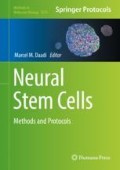Abstract
Rapid and reliable assessment of mitochondrial bioenergetics is a vital tool in drug discovery studies aimed at reversing or improving mitochondrial dysfunction. Induced pluripotent stem cell (iPSC)-derived neural stem cells (NSCs) carry and replicate the donor disease pathology and can be an ideal cellular model for phenotypic screening of compounds. Herein we describe the use of Seahorse XFe96 analyzer to assess mitochondrial functions in iPSC-derived NSCs for drug screening.
Access this chapter
Tax calculation will be finalised at checkout
Purchases are for personal use only
References
Lin MT, Beal MF (2006) Mitochondrial dysfunction and oxidative stress in neurodegenerative diseases. Nature 443(7113):787–795
Zhang J et al (2012) Measuring energy metabolism in cultured cells, including human pluripotent stem cells and differentiated cells. Nat Protoc 7(6):1068–1085
Brand MD, Nicholls DG (2011) Assessing mitochondrial dysfunction in cells. Biochem J 435(2):297–312
Wang R et al (2015) The acute extracellular flux (XF) assay to assess compound effects on mitochondrial function. J Biomol Screen 20(3):422–429
Koopman M et al (2016) A screening-based platform for the assessment of cellular respiration in Caenorhabditis elegans. Nat Protoc 11(10):1798–1816
Ozsvari B et al (2017) Mitoriboscins: Mitochondrial-based therapeutics targeting cancer stem cells (CSCs), bacteria and pathogenic yeast. Oncotarget 8(40):67457–67472
Ribeiro SM, Gimenez-Cassina A, Danial NN (2015) Measurement of mitochondrial oxygen consumption rates in mouse primary neurons and astrocytes. Methods Mol Biol 1241:59–69
Clerc P, Polster BM (2012) Investigation of mitochondrial dysfunction by sequential microplate-based respiration measurements from intact and permeabilized neurons. PLoS One 7(4):e34465
Jiang T, Cadenas E (2014) Astrocytic metabolic and inflammatory changes as a function of age. Aging Cell 13(6):1059–1067
Roy Choudhury G et al (2015) Methylene blue protects astrocytes against glucose oxygen deprivation by improving cellular respiration. PLoS One 10(4):e0123096
Park SJ et al (2017) Metabolome profiling of partial and fully reprogrammed induced pluripotent stem cells. Stem Cells Dev 26(10):734–742
Panopoulos AD et al (2012) The metabolome of induced pluripotent stem cells reveals metabolic changes occurring in somatic cell reprogramming. Cell Res 22(1):168–177
Rana P et al (2012) Characterization of human-induced pluripotent stem cell-derived cardiomyocytes: bioenergetics and utilization in safety screening. Toxicol Sci 130(1):117–131
van der Windt GJ, Chang CH, Pearce EL (2016) Measuring bioenergetics in T cells using a seahorse extracellular flux analyzer. Curr Protoc Immunol 113:3 16B 1–3 16B 14
Dong Z et al (2016) Focused screening of mitochondrial metabolism reveals a crucial role for a tumor suppressor Hbp1 in ovarian reserve. Cell Death Differ 23(10):1602–1614
Acknowledgment
The authors thank the members of the Daadi laboratory for their helpful support and suggestions. This work was supported by the Worth Family Fund, the Perry & Ruby Stevens Charitable Foundation, the Robert J., Jr. and Helen C. Kleberg Foundation, the NIH primate center base grant (Office of Research Infrastructure Programs/OD P51 OD011133), and the National Center for Advancing Translational Sciences, National Institutes of Health, through Grant UL1 TR001120.
Disclosures: Dr. Marcel M. Daadi is founder of the biotech company NeoNeuron.
Author information
Authors and Affiliations
Corresponding author
Editor information
Editors and Affiliations
Rights and permissions
Copyright information
© 2019 Springer Science+Business Media, LLC, part of Springer Nature
About this protocol
Cite this protocol
Roy-Choudhury, G., Daadi, M.M. (2019). Assay for Assessing Mitochondrial Function in iPSC-Derived Neural Stem Cells and Dopaminergic Neurons. In: Daadi, M. (eds) Neural Stem Cells. Methods in Molecular Biology, vol 1919. Humana Press, New York, NY. https://doi.org/10.1007/978-1-4939-9007-8_12
Download citation
DOI: https://doi.org/10.1007/978-1-4939-9007-8_12
Published:
Publisher Name: Humana Press, New York, NY
Print ISBN: 978-1-4939-9005-4
Online ISBN: 978-1-4939-9007-8
eBook Packages: Springer Protocols

